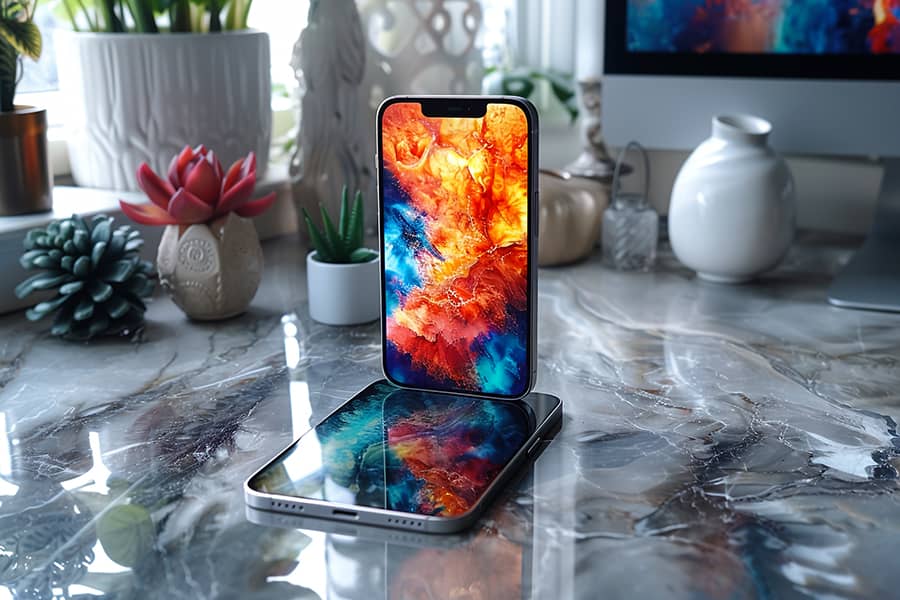The Samsung Galaxy S25 Ultra is said to feature bezels that are even slimmer than those of the iPhone 16 Pro Max.

Overview of Samsung Galaxy S25 Ultra
The Samsung Galaxy S25 Ultra is set to transform the realm of flagship smartphones with its stunning design and state-of-the-art technology. A remarkable attribute is the notably smaller bezel size, which not only boosts visual appeal but also maximizes display space. This feature enables users to enjoy an engaging viewing experience whether they’re browsing social media or engrossed in their favorite series. With speculations indicating that these bezels will outclass those on Apple’s iPhone 16 Pro Max, Samsung appears intent on advancing both performance and aesthetics.
In addition to its striking appearance, the S25 Ultra is believed to incorporate innovations in display technology that could establish a new benchmark for color accuracy and brightness levels. Sources within the industry speculate about enhancements in dynamic refresh rates and adaptive brightness functions aimed at catering not only to gaming fans but also photographers and videographers who demand precision in every detail. The expected inclusion of AI-powered features promises a more tailored interaction with applications, facilitating smarter multitasking—a capability that might make daily tasks feel fluid.
Design Innovations: Slimmer Bezels Explained
As the tech market races toward the ultra-sleek, slimmer bezels have emerged as a design hallmark that not only captivates visually but also enhances functionality. The Samsung Galaxy S25 Ultra’s anticipated feature of reduced bezels over the iPhone 16 Pro Max showcases a paradigm shift in smartphone design where minimalism meets user experience. With less bezel comes more screen real estate, allowing manufacturers to push boundaries while retaining compact form factors—perfect for our increasingly mobile lifestyles.
Moreover, slimmer bezels contribute to an immersive display experience that transforms how we interact with content. Whether watching videos or gaming, users can enjoy edge-to-edge visuals that heighten engagement and satisfaction. Additionally, these innovations often mean advancements in display technology; as designs become sleeker, engineers find creative ways to enhance durability and performance without compromising aesthetic appeal. In essence, slim bezels are not just about looking good; they reflect a deeper dialogue between design innovation and consumer-centric functionality, defining what it means to hold the future of technology in your hand.
Comparing Bezels: Galaxy S25 vs. iPhone 16 Pro Max
When discussing bezels, the ongoing rivalry between Samsung and Apple has consistently captured the attention of technology aficionados. The Galaxy S25 Ultra is rumored to showcase even slimmer bezels compared to the iPhone 16 Pro Max, prompting an interesting discussion about how these design aspects impact user experience. A narrower bezel not only maximizes display space but also enhances an overall sleeker look that attracts contemporary consumers who increasingly prefer edge-to-edge displays.
Furthermore, the benefits of thinner bezels go beyond just aesthetics; they influence usability too. For instance, Samsung often emphasizes innovation in interactive edges and navigation gestures that thrive on ample screen space. Conversely, Apple’s larger notch on the iPhone 16 Pro Max accommodates sophisticated Face ID technology but introduces a noticeable disruption to the immersive experience. This contrast encourages users to evaluate aesthetics against functionality—where one inclination may draw someone toward Samsung’s streamlined design while another could sway them towards Apple’s strong security features.
Display Technology: Advancements in Screen Design
As the competition heats up between flagship smartphones, the evolution of display technology takes center stage. With brands like Samsung pushing the envelope on bezel size, we witness a paradigm shift in how screens are designed and utilized. The slimmed-down bezels not only enhance aesthetics but also maximize screen real estate, inviting users into a more immersive digital experience. This trend translates to devices that appear sleeker and more futuristic while allowing for larger displays without significantly increasing device dimensions.
Moreover, advancements in OLED and AMOLED technologies contribute to these developments, offering deeper blacks and more vibrant colors in thinner panels than ever before. Manufacturers are also experimenting with under-display camera tech and innovative materials that promise greater durability alongside stunning visuals. As layers of glass thin out without sacrificing resilience, future devices like the Samsung Galaxy S25 Ultra might redefine what we expect from our everyday screens—making interactions feel fluidly integrated rather than simple engagements with a flat surface. Ultimately, as design converges with cutting-edge technology, our relationship with our smartphones is set for radical transformation—one inch at a time.
User Experience: Impact of Slimmer Bezels
The trend towards slimmer bezels represents more than just an aesthetic choice; it fundamentally alters the user experience by expanding the screen real estate. When bezels shrink, users are treated to a more immersive display, enhancing everything from gaming to video streaming. Imagine binge-watching your favorite series on a device where the image seems to extend to every edge—this not only captivates users visually but also heightens emotional engagement with content.
Moreover, thinner bezels open up creative possibilities for app developers and UI/UX designers. With less clutter around the screen, design elements can be optimized for a full-screen experience, enabling innovative features like gesture navigation and dynamic wallpapers that react to changes in display dimensions. This shift encourages a rethinking of how users interact with their devices beyond mere touch; it’s about crafting experiences that feel alive and responsive in ways previous models couldn’t achieve. From practical benefits like increased productivity to pure visual pleasure, slimmer bezels mark a significant leap forward in how we perceive and use our smartphones.
Camera Features: Enhancements in the S25 Ultra
The camera enhancements in the Samsung Galaxy S25 Ultra push boundaries further than ever before, particularly appealing to mobile photographers and videographers. One standout feature is the rumored integration of advanced AI-assisted shooting modes that intelligently adjust settings based on real-time scene analysis. This not only simplifies photography for casual users but also empowers professionals with tools that mimic higher-end DSLR capabilities right from their pocket.
Another intriguing development is the expected introduction of a multi-lens system boasting a periscope zoom lens capable of unprecedented optical magnification without sacrificing quality. With these advancements, capturing distant subjects becomes effortless, while the ultra-wide lens promises striking perspectives with minimal distortion—a critical improvement for landscape enthusiasts. The enhanced low-light performance, fueled by larger sensors and improved image processing algorithms, ensures that those late-night escapades don’t result in blurry reminders; instead, they emerge as vibrant recollections etched in stunning clarity. As Samsung continues to refine its flagship offering, it’s clear that the S25 Ultra aims to redefine what users can achieve beyond just high-resolution images—transforming everyday moments into extraordinary visual narratives.
Battery Life: Efficiency with a Sleeker Design
As smartphones become increasingly streamlined, advancements in battery technology are essential to ensure that performance doesn’t lag behind innovation. The Samsung Galaxy S25 Ultra’s sleeker design not only turns heads but also offers an opportunity for engineers to reimagine energy efficiency. With a reduction in bezel size, Samsung may leverage the additional space to enhance thermal management and power distribution within the device, ultimately extending its battery life without compromising on aesthetics.
Moreover, this push towards slimmer profiles aligns with emerging technologies like improved lithium-ion and solid-state batteries, which can provide higher energy density without increasing size or weight. This evolution means users might soon enjoy all-day usage even with a trimmed-down chassis. As the trend of minimizing bezels continues, we’re likely to witness a shift where sleek design harmonizes with innovative battery solutions—resulting in devices that keep pace with our fast-moving digital lives while maintaining stunning visuals and form factors we crave.
Pricing and Availability: What to Expect?
As the excitement around the Samsung Galaxy S25 Ultra builds, potential buyers are keenly interested in its pricing and availability. Industry analysts suggest that Samsung is aiming to position the S25 Ultra competitively against flagship counterparts like Apple’s iPhone 16 Pro Max while justifying an expected increase in price due to premium features. With advanced technologies such as even slimmer bezels and enhanced camera systems, a starting price of approximately $1,200 could become a reality. However, if history is any indicator, promotional bundles or trade-in incentives might soften the financial blow for consumers eager to own this cutting-edge device.
Availability is another aspect worth scrutinizing. With supply chain uncertainties still lingering from previous years, predictions point towards staggered releases across various markets—something tech enthusiasts should keep an eye on. Early adopters may find it easier to secure their devices through pre-orders, potentially accompanied by exclusive perks or limited edition accessories. As we anticipate official announcements from Samsung, those hoping to get their hands on the Galaxy S25 Ultra should also consider timing; waiting for initial reviews could yield invaluable insights into user experiences and performance benchmarks before committing to purchase.
Consumer Reactions: Early Impressions and Feedback
Consumer responses to the Samsung Galaxy S25 Ultra have been a flurry of enthusiasm and intrigue, especially concerning its design elements. Numerous tech aficionados are abuzz about the speculated thinner bezels, drawing comparisons not only with Apple’s iPhone 16 Pro Max but also with benchmarks for high-end smartphones. This evolution signifies more than just a superficial upgrade; it underscores Samsung’s dedication to pushing limits, striving to provide an engaging viewing experience that enthralls users.
Initial feedback indicates a rising appreciation for how these state-of-the-art designs improve usability while maintaining functionality. Users are captivated by the nearly bezel-less display that puts content front and center, encouraging immersive engagement whether for gaming or streaming media. Additionally, early remarks on social channels show a strong interest in how these visual transformations might affect their buying decisions—signifying a crucial moment in brand loyalty as consumers contemplate the ramifications of each manufacturer’s distinctive offerings.
Conclusion: The Future of Smartphone Design
As we look towards the future of smartphone design, it becomes evident that the trend is moving toward an immersive experience that transcends mere aesthetics. With advancements in materials and manufacturing techniques, manufacturers will likely prioritize functionality alongside slim designs. This could lead to innovations like flexible displays that wrap around the edges or even foldable screens incorporating high durability without sacrificing visual appeal.
Moreover, as consumer preferences evolve, so too will the integration of sustainable practices within smartphone design. Future devices may utilize eco-friendly materials and modular components, allowing users to replace parts rather than purchase entirely new models. This shift not only caters to environmentally-conscious consumers but also addresses concerns about electronic waste—an area increasingly crucial for tech-savvy buyers who are becoming more discerning about their environmental impact. Ultimately, as companies like Samsung push boundaries with devices like the Galaxy S25 Ultra, we’re poised for a renaissance in how smartphones blend technology with artistry and responsibility.
Recent Posts
-
Advice for achieving a healthier and more joyful lifestyle
September 16, 2024 -
Brazil: The premier location for thrilling adventures
September 14, 2024




